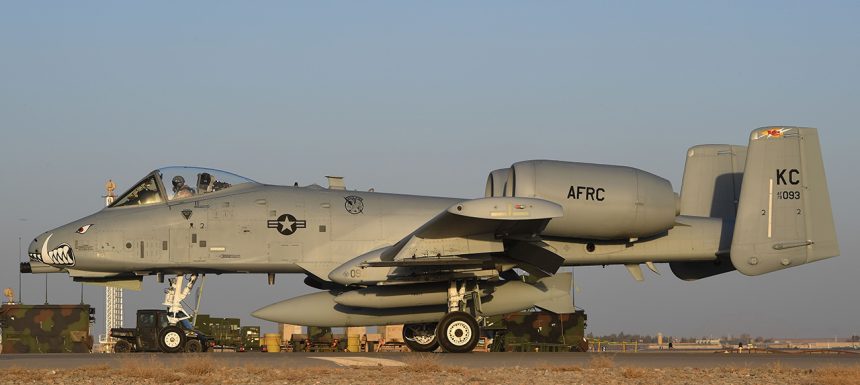After 3 years, the “Warthog” returns to Afghanistan.
A dozen A-10C Thunderbolt II ground attack aircraft have arrived at Kandahar Airfield, Afghanistan, on Jan. 19 to bolster (USFOR-A) and Afghan National Defense and Security Force’s (ANDSF) air campaign against the Taliban.
The aircraft belong to the 303rd Expeditionary Fighter Squadron and arrived in Afghanistan via Al Udeid, Qatar. The aircraft were originally headed for Incirlik, in Turkey, to join the fight on ISIS, but the Pentagon decided to “divert” the A-10s to Afghanistan, to support the increased need for close air support and precision strike capacity against Taliban and their revenue sources.
According to an official release, “the arrival of these aircraft follows a recent decision by U.S. Air Forces Central Command to realign aircraft, airmen, and assets already in the U.S. Central Command AOR to Kandahar Airfield, Afghanistan, to support increased airpower requirements of ANDSF and USFOR-A to implement South Asia Policy under Operation Freedom’s Sentinel. Along with a detachment of KC-135 Stratotankers that have operated from Kandahar since September, the A-10s, MQ-9s and HH-60G will complement F-16s, C-130J, EC-130H and other aircraft supporting these operations from Bagram Airfield.
These increased assets will assist with the ongoing ANDSF strategic air campaign that targets Taliban revenue sources of which are aimed at aggressively taking the fight to the Taliban.”
Along with the Thunderbolt squadron, additional aircraft will be moved to Kandahar Airfield, including MQ-9 Reapers that provide armed over-watch and intelligence, surveillance and reconnaissance of the battlefield, and HH-60G Pave Hawk helicopters, to conduct personnel recovery and search and rescue.
Commonly known as the Warthog, the A-10 will be launched in air strikes against Taliban narcotics production facility. According to the U.S. Air Force, since November, 30 strikes conducted against Taliban narcotics production facilities resulted more than $20 million in total impact on Taliban revenue.
With a relatively low-cost platform much closer to these targets than the Raptors supporting Operation Inherent Resolve from the Persian Gulf, such anti-drug air strikes will also be more cost-effective: on Nov. 20, F-22 Raptors forward deployed to at Al Dhafra Air Base, United Arab Emirates, and supported by KC-10 Extender from the 908th Expeditionary Air Refueling Squadron, also based at Al Dhafra Air Base, launched their first air strikes in Afghanistan employing small diameter bombs to hit plantations of poppy (processed into illegal opiate drugs such as heroin) in Helmand Province.
Under the authorities granted in the South Asia Policy, precision strikes with A-10s will hit the Taliban where they are most vulnerable: their revenue streams and profits from developing and selling illegal narcotics.
“The A-10 provides planners even more options given its ability to deliver a wide variety of precision munitions and devastating firepower from its 30mm cannon,” said U.S. Air Force Brigadier General Lance Bunch, chief, Future Operations, CJ35. “In the coming weeks, the A-10’s operations will be integrated into our combined U.S. and Afghan air campaign to deliver destructive precision firepower that sends a strong impactful message to the Taliban.”
By the way, whereas it continues to rely on the A-10 to perform CAS in Afghanistan, the U.S. Air Force is letting the Thunderbolt die by shelving plans to replace the remaining wings on the rest of its A-10C fleet.
The U.S. A-10s will be complemented by the Afghan Air Force (AAF) assets, that will more than double their fleet of aircraft over the next seven years: besides the introduction of A-29 ground attack aircraft, C-208 and C-130 mobility aircraft, MD-530, and Mi-17 helicopters last year, plans include the introduction of AC-208 attack aircraft and UH- 60 Black Hawk assault helicopters, as well as additional A-29 attack aircraft and MD- 530 attack helicopters.
“The growing Afghan Air Force is vital to the success of ANDSF on the battlefield,” said Major General Mohammad Shoaib, commander, AAF. “Dedicated pilots and crews provide resupply, close air attack, casualty evacuation, and air assault capabilities to their brothers on the ground. The success of the Air Force is key to tipping the battlefield in favor of ANDSF. The Afghan Air Force is successfully fighting and growing at the same time increasing attack capabilities while delivering daily blows to the Taliban.”
If you are interested in the A-10, don’t miss our “BRRTTTT….deployments, war chronicles and stories of the last A-10 Warthogs” available both in ebook format and paperback version from Amazon.









